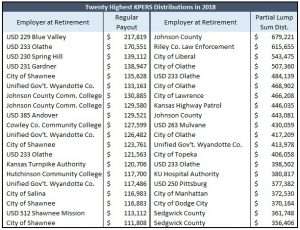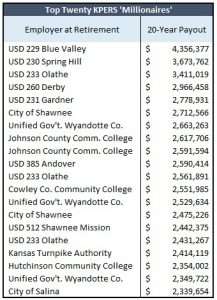An Open Records request fulfilled by the Kansas Public Employees Retirement System (KPERS) shows record-setting payouts in 2018 of $1.7 billion. The number of KPERS ‘millionaires’ also set a new record, with 2,522 government retirees expected to receive more than $1 million in pension benefits over the first 20 years of retirement; that’s 188 more ‘millionaires’ than last year. Pensions are paid over the lifespan of each retiree, so actual payouts could be different.
 Retirees have the option of taking a partial lump sum distribution upon retirement and collecting smaller monthly payments after that. The twenty largest distributions from monthly payments are listed in the table below, alongside the twenty largest lump sum payments. School employees dominate the list of top monthly payouts, with the top four recipients and three others in the top 20. The highest payout went to a USD 229 Blue Valley employee who collected $217,819 last year. A Johnson County retiree received the largest lump sum distribution of $679,221. A complete list of payouts is at KansasOpenGov.org.
Retirees have the option of taking a partial lump sum distribution upon retirement and collecting smaller monthly payments after that. The twenty largest distributions from monthly payments are listed in the table below, alongside the twenty largest lump sum payments. School employees dominate the list of top monthly payouts, with the top four recipients and three others in the top 20. The highest payout went to a USD 229 Blue Valley employee who collected $217,819 last year. A Johnson County retiree received the largest lump sum distribution of $679,221. A complete list of payouts is at KansasOpenGov.org.
 Educators dominate the 20 highest KPERS ‘millionaires’ list. There are nine school district employees in the top twenty and four retirees from community colleges. The Unified Government of Wyandotte County has three members of the top 20, and the City of Shawnee has two members.
Educators dominate the 20 highest KPERS ‘millionaires’ list. There are nine school district employees in the top twenty and four retirees from community colleges. The Unified Government of Wyandotte County has three members of the top 20, and the City of Shawnee has two members.
Educators also comprise the largest portion of the full list of KPERS ‘millionaires.’ School districts, education service centers and the Kansas Department of Education (KSDE) collectively have 709, or 28 percent of the total. Cities and counties have the next largest share, with 654 ‘millionaires’ and 26 percent of the total. The Unified Government of Wyandotte County comes in third with 258 members, followed by Johnson County with 167 members. Community and technical colleges round out the top five employers, with 122 ‘millionaires’.
The KPERS system covers employees of state government, local government, school districts, and even some employees of private entities associated with the government. Some university employees participate in KPERS, but most have a different retirement system. KPERS retirees who reside in Kansas also receive preferential tax treatment. Employee contributions are subject to state income tax when made, but their withdrawals are exempt from state income tax, meaning government retirees are never taxed on most of their pension benefits, which come from employer contributions and earnings on all contributions.




